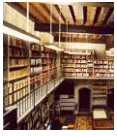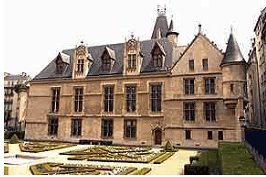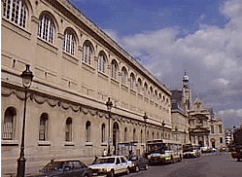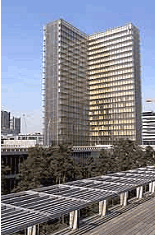Librairies

© Paris Tourist Office
As there are 70 lending libraries in the city
of Paris, there has to be one near where you’re staying!
They provide the ideal setting for doing some research or studying
in peace.
In order to lend books, you will have to consult the rules of
the individual library. University libraries in the city are open
to students and researchers. For further information, you should
consult our rubric studying
1 rue de Sully, rue de l'arsenal
(métro Sully-Morland) (entrance on place Teilhard de Chardin, tel. 01 42 76 33 97 or 01 42 72 19 09 open 10.00-17.00 except Sundays).
BIBLIOTHEQUE DE L'ARSENAL

BIBLIOTHEQUE DE L'ARSENAL
Towards the end of the 18th century, the Marquis of Paulmy d’Argenson, Grand Master of the Artillery, brought together a collection of medieval works – at a time when the middle ages were considered an obscure era. Completed with the collections of other aristocrats, the library was then further enriched with the archives of the Bastille and with books confiscated by convents. The library opened to the public in 1797. It possesses numerous manuscripts from the middle ages, notably works devoted to stage arts. Plans are currently under way to transfer its collections, since the National Library has moved to Tolbiac.
BIBLIOTHEQUE FORNEY

Source:
www.parisbalades.com
1 rue du Figuier
(tel. 01 42 78 14 60, open 13.30-20.00 except Sundays and Mondays,
Saturday from 10.00-20.30)
Founded in 1886, the library has much to offer
for lovers of art and architecture: books, periodicals, slides,
posters, samples of 18th century materials, designs for furniture
and ironworks, collections of wallpapers… To the right of
the hôtel de Sens, the French-style garden is accessible
(to view) from an alley (open 08.30 – 12.30). The garden
leads to the youth hostel MIJE,
11 rue du Fauconnier (you must arrive in the morning).
BIBLIOTHEQUE NATIONALE DE FRANCE, SITE RICHELIEU

© Paris Tourist Office -
Photographe : Henri Garat
(tel. : 01 53 79 53 79, open to researchers
9.00-18.00, except Sundays. Only the Mazarine and Mansart galleries
are open, when temporary exhibitions are on display. The medal
cabinet is open 13.00-17.00, tel. 01 53 79 83 34. Guided visits:
01 44 61 21 69)
The first royal library was assembled in the
Louvre by Charles V: the 973 unnumbered volumes collected there,
however, were sold in 1373 and became dispersed. The real origins
of the library go back to the Valois family: Louis XII and François
I assembled libraries in their palaces at Blois and Fontainebleau.
In 1537 a literary registration law was introduced: every editor
was required to provide the library with one copy of each work
published. In 1692, the library was opened to the public –
under certain conditions. Needing more space, Colbert had some
of the books transported to two houses that he owned on rue Vivienne
and in two hotels that belonged to Mazarin, where Mansart built
two parallel galleries on rue de Richelieu (now called the Mazarin
and Mansart galleries). Opened to the learned in 1720, the library
continued to be enriched and catalogues were established. Near
the end of the 18th century, the Revolution caused an influx of
books: the collections of cnvents and nobles who had fled the
country were confiscated, and the literary registration law was
reinforced. The law exists to this day, and currently 40,000 works
are submitted to the National Library each year.
While improvements in printing technology were allowing the production
of books to increase, it was not until the 1860’s that the
architect Labrouste radically transformed the design of the library.
He built an entrance façade on the square Louvois, a vast
reading room and central store, and all was lit up by carefully
placed windows. The new buildings were supported with the innovative
system of metal girders, remarkable at the time for its very new
aesthetic effects. 12 million books, periodicals, a record and
audio visual library were transferred in 1999 to a site in Tolbiac,
in the 13th arrondissement. The traditional “BN” (National
Library) kept its specialist collections of manuscripts, stamps,
sheet music, old maps, photos, theatre costumes, medals and coins.
.
BIBLIOTHEQUE SAINTE-GENEVIEVE

Source:
www.parisbalades.com
10 place du Panthéon
(tel. 01 44 41 97 98, open 10.00-22.00 except Sundays) architect:
Labrouste, 1844
In 1844, the architect Labrouste used for the
first time the new materials of the 19th century in the construction
of a public building. Iron and cast iron were strong, non-flammable,
cheap and allowed for both admittance of natural light and lightness
of architecture. The austere façade contrasts with the
rich interior décor inspired by the paintings on the ancient
monuments of Rome.
BIBLIOTHEQUE NATIONALE DE FRANCE
(FRANÇOIS MITTERRAND)

Source:
www.parisbalades.com
11 quai François Mauriac
(BIBLIOTHEQUE
FRANCOIS MITTERRAND)
(metro Quai de la Gare) (tel. 01 53 79 53 79 or 01 53 79 59 59,
exhibitions open 10.00-19.00 except Mondays, Sundays 12.00 - 18.00).
(reading and research rooms. Overlooking garden open 10.00-20.00
except Mondays, Sundays 12.00-19.00. Garden level open 9.00 -
20.00 except Sundays), (architect: Dominique Perrault, 1996)
The building is situated on the prestigious banks
of the Seine (parts of which are classified as a UNESCO world
heritage site), Dominique Perrault wanted to “signal”
the presence of the library without creating an effect that would
be too massive (the total floor surface is three times the size
of Beaubourg). He chose to construct four large towers enclosing
a square garden. Some saw the shape of the buildings as a metaphor
for an open book.
The towers appear transparent because of a gap between the glass
exterior and the book containers, made of leather, aluminium or
zinc (the architect worked on the principle of “no-contact
between materials”): they contain books on 11 shelves, which
caused heated arguments as to how the books would be protected
from sunlight. Offices are contained in the first 7 storeys, while
reading rooms (1,100 places for the general public, 2,000 places
for researchers giving on to an inaccessible garden) are spread
out under an esplanade of white (and slippery) wood. The esplanade
can seem a little bleak, with its street lights and heavy railings
that block the view of the garden…
The trees in the garden, however, are still young, and should
change the aspect of the place as they grow.
The BNF has also just opened its phonetics and audiovisual department, which will offer in the region of a million audio documents, thanks to a 1925 law requiring a copy of every disk recording to be provided to the library. It is the INA, however, that receives copies of radio recordings (tel: 01 53 79 59 59). In 1999, a stretch of land along avenue de la France was chosen as the site for a “City of Image and Sound”, built by Jean-Michel Wilmotte.
BIBLIOTHEQUE PUBLIQUE D'INFORMATION (BPI) RELIE AU SITE DE LA BIBLITOTHEQUE DU CENTRE POMPIDOU.

Source:
www.parisbalades.com
(Open 12.00 - 22.00 except Tuesdays, 11.00 - 22.00 Saturdays and Sundays)
Opened in 1977 at the same as the Pompidou Centre, the founding principle of the Public Information Library was innovative: to give access to accumulated human knowledge to the greatest possible number of people by organising a library that would be open to all, with no admission charge and free access to the books.
- Paris-city Partners :
- Music News
- Rock, Jazz & Blues CDs
- Learn French in Paris
- Learn French in France
- Paris Junior Programs
- Learn English in England
- Business English Courses
- Need a translation?
- For teachers of French
- French Exercise & Tests
- Directories
- English courses for Teens in UK
- Camps for Teens in England
- Language Courses Abroad
- English courses in England
- Learn a Language Abroad


